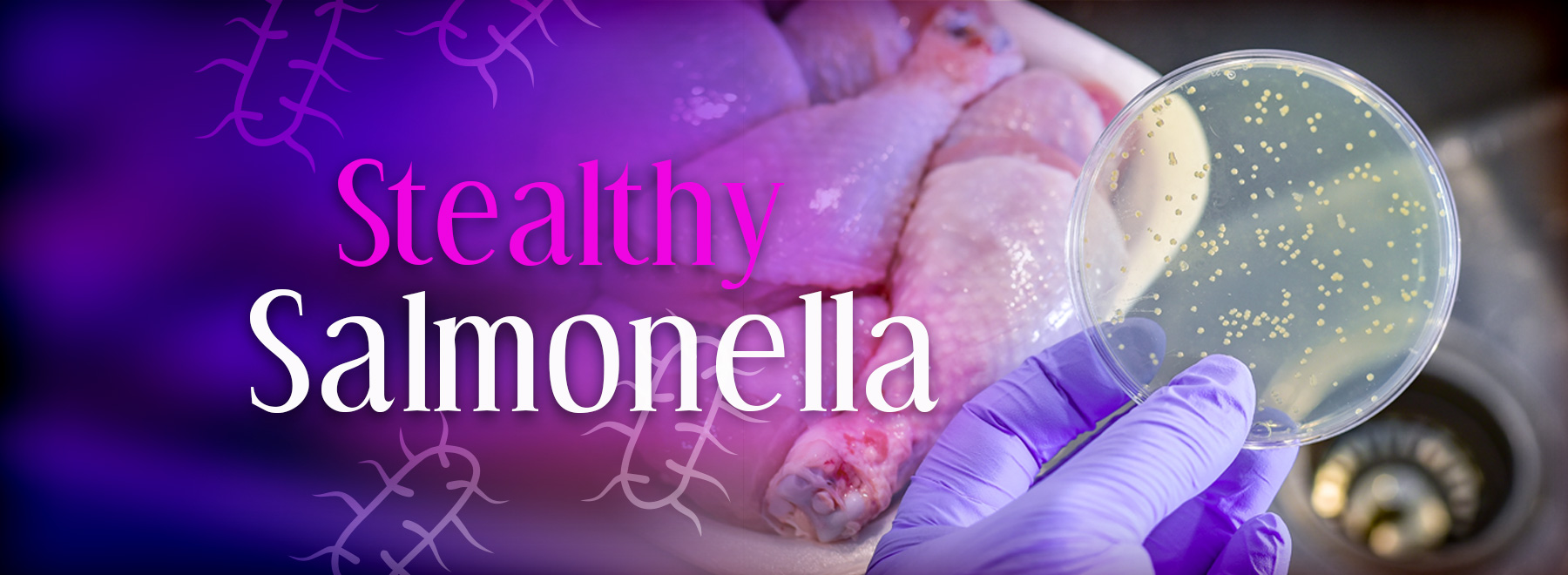It evades your nose and your eyes, but it’s often at hand
It’s not every day that peanut butter, dog food, chocolate and chickens can be excused for appearing in the same sentence; lately, though, they’ve shared a common denominator: salmonella.
Salmonella is deceitful. Usually, you can’t see, smell or taste it in or on the offender. But you can certainly feel it; headaches, fever, abdominal cramps, nausea and vomiting are just some of the symptoms of an infection.
A case of salmonella (that’s the name of the bacteria; “salmonellosis” is the illness) can be severe enough to justify recalls of certain food products or to prompt public warnings against hugging your chickens.
Particularly now, in this massively hot season of picnics, sun-curdled potato salad and poor temperature control, it is wise to turn to experts for tips on avoiding this rarely fatal, but often prostrating, disease.

“Salmonellosis is especially severe in children under age 5 and in adults over 65 – especially ones who have a weakened immune system; for example, in those undergoing cancer treatment or for those with diabetes,” said Dr. Charlotte Hobbs, professor of pediatric infectious diseases and microbiology at the University of Mississippi Medical Center.
“For clinical and public health purposes, there is essentially typhoidal and non-typhoidal salmonella; the first one can be more commonly associated with travel abroad, and the latter can be acquired anywhere, notably the U.S.
“Public health agencies, including our departments of health and, ultimately, the Centers for Disease Control and Prevention, will receive positive specimens from hospitals and clinics; they characterize the type of salmonella and track clusters of cases, or outbreaks, since this is a public health concern.”

The illness can be “mild to severe,” said Dr. Jasmine Kency, assistant professor of internal medicine and pediatrics at UMMC.
“Some people can run a fever. There can be diarrhea; sometimes it’s bloody. Sometimes there’s lethargy, fatigue, decreased appetite. With severe cases there may be a high heart rate or low blood pressure.”
You can get salmonellosis by eating contaminated foods, Hobbs said. “These may be unpasteurized eggs, or vegetables, meats such as chicken and pork, and even frozen foods such as chicken nuggets or pot pies, especially those containing chicken; and, as we have seen recently, nut butters such as peanut butter.
“The food will not smell or look unusual, however. Your risk can be reduced, though, by proper food handling and hygiene, and observing food recalls.”
So, cooking food properly and practicing proper hand hygiene are other ways to head off salmonellosis at the pass. The U.S. Department of Agriculture is a helpful source for safe-temperature cooking.
Salmonella infections can also spread by contact with the organism, along with improper hand hygiene, Hobbs said. “If, for instance, you’ve used the same toilet as someone who has been infected, or when changing diapers, or by helping to clean up stool and then you don’t wash your hands properly, you can ingest the organism and become ill.”
This brings up three steps for prevention, Kency said. “Hand hygiene, hand hygiene, hand hygiene – that is the biggest thing.
“Also, make sure you sanitize your work station when you’re preparing food in your kitchen, especially when you’re working with raw meat. Sanitize knives and countertops. Even in your fridge, make sure you’re wiping that down, especially if it has stored raw meat.”
The deviousness of salmonella is manifold. People can have salmonellosis, but no symptoms – and they can still spread it, Kency said.
“A group could go out to eat together; some get food poisoning and show symptoms; others in that same group may not get sick at all.”
As we have already seen with chickens, animals can be carriers. “They can be reptiles, even small rodents like hamsters and, of course, birds,” Hobbs said.
“People who keep reptiles as pets should wash their hands carefully; if they are cleaning terrariums, for example, do not do it in the kitchen sink. Do it outside or at least somewhere that can be thoroughly disinfected.
“People who keep chickens should also be aware of the recent outbreak reported by the CDC, including cases in Mississippi, associated with backyard poultry. Chicken eggs that are not commercially pasteurized are riskier for salmonella. Summertime is especially ripe for salmonella transmission with regard to food safety.
“That’s why we always need to make sure we refrigerate food promptly, including leftovers, separate meat and fruit and vegetable prepping and that we wash our hands always before eating and after coming into contact with animals.
“This does mean pets, petting zoos, and even their food. There have been reports of people getting infected from contaminated pet foods that are animal-derived.
“Also, if someone is ill, they should not be preparing food for others.”
Once you bring home the bacon, etc., it’s important to store it in the refrigerator. “That means within two hours after food has been prepared – cut, peeled, cooked – or within one hour if it has been in a hot car,” Hobbs said.
“Fruits and vegetables have to be washed thoroughly under clean running water, even the peel, even if you don‘t eat it, because cutting through the peel can drag bacteria through the fruit or vegetable. A few years ago, we all may recall, there was a salmonella-associated recall for pre-packaged salads, so it never hurts to re-wash one’s veggies.
“Also: Remove damaged, bruised areas; do not eat them.”
If you are going to suffer from gastroenteritis – what people often call “stomach flu” – because of non-typhoidal salmonella, it will happen, usually, within six to 48 hours after ingestion, Hobbs said. “But incubation periods of up to a week have been reported.”
Depending on the type of salmonella, an infected person can be contagious for a while, even up to a year, which has been documented with various types of salmonella, Hobbs said.
The sickness is usually done within a week, and there’s not much to do about it in the meantime, except drink plenty of water or clear fluids to avoid dehydration. However, with serious cases, there is a course of action, Hobbs said.
“Aggressive antibiotic treatment is used for people for whom salmonellosis can lead to more severe infection. Treatment can require weeks of IV or oral antibiotics, depending on how far it has spread in the body.
“Many people who get salmonella, however, may not realize they’ve had it, as they would not likely be sick enough to have their stools tested. So, it is thought that there are many more people infected and carrying salmonella than we know.”
Deceitful to the end.
The above article appears in CONSULT, UMMC’s monthly e-newsletter sharing news about cutting-edge clinical and health science education advances and innovative biomedical research at the Medical Center and giving you tips and suggestions on how you and the people you love can live a healthier life. Click here and enter your email address to receive CONSULT free of charge. You may cancel at any time.



